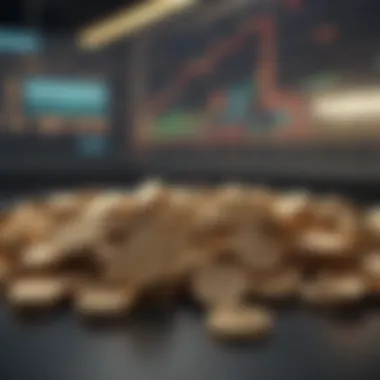Exploring US Commodity ETFs: Insights and Strategies


Market Overview
Navigating the landscape of Commodity Exchange-Traded Funds (ETFs) requires an understanding of the current market environment and underlying economic principles.
Current Market Sentiment
The mood in financial markets can sway daily based on news, economic data, or geopolitical events. Investors show a mix of optimism and caution regarding commodity ETFs. For instance, with inflationary pressures presenting challenges, commodities like gold and oil are often viewed as safe havens. However, fluctuating supply and demand dynamics can bring unpredictability. This sentiment has seen both seasoned traders and newcomers engaging with commodities, indicating a resurgence in interest that is hard to ignore.
Major Indices Performance
Commodity ETFs are often linked to major commodity indices like the S&P GSCI or Bloomberg Commodity Index. The performance of these indices reflects the volatility and price trends of the underlying assets, offering insights into investor behavior and market trends. Recently, indices tracking energy commodities, particularly crude oil, have exhibited considerable growth, while agricultural commodity indices might face headwinds due to varying weather patterns. Prior analysis clearly shows how far behind the performance of these indices can differ, based on both global and local influences.
Economic Indicators Analysis
Economic indicators play a significant role in understanding the Commodity ETF landscape. Key metrics such as GDP growth, unemployment rates, and inflation rates can impact commodity prices significantly. For example, an uptick in jobs may lead to increased fuel consumption, driving up oil prices, and subsequently impacting oil ETFs. The correlation is paramount. It’s essential to keep an eye on these indicators to gauge future trends accurately. Additionally, trade policies can create a ripple effect, most notably in agricultural commodities like soybeans and corn, where tariffs can affect export dynamics.
"Understanding the interplay between economic indicators and commodity performance is crucial for informed investment decisions."
Keeping abreast of the ever-evolving economic landscape positions investors favorably, helping them adapt and refine their strategies based on real-time market conditions.
Understanding the Nature of Commodity ETFs
Commodity ETFs not only offer investors a route to gain exposure to various commodities but also serve as a strategic tool for portfolio diversification. By grasping the fundamental workings of these funds, traders can make more informed choices and optimize their returns. Pricing often mirrors the performance of specific commodities or commodity indices, creating a direct link between the ETF and the broader commodity market.
Key Benefits of Commodity ETFs
The benefits are plenty. Firstly, the liquidity of ETFs allows investors to buy and sell throughout the trading day, unlike traditional mutual funds. Moreover, ETFs can track a wide variety of commodities: from natural resources like gold and silver to agricultural products like wheat and corn.
Risks Involved
However, it is equally vital to be aware of potential pitfalls. Commodity prices can be extremely volatile, influenced by factors such as geopolitical tensions or climate events. Investors should remain vigilant, focusing on risk management and informed decision-making to navigate this space successfully.
Understanding how these elements influence the price of commodity ETFs can provide investors a significant advantage in their investment journeys.
Preface to Commodity ETFs
Commodity ETFs, or Exchange-Traded Funds that focus on physical goods, have emerged as a significant investment vehicle within the financial markets. Understanding commodity ETFs is crucial for investors, whether they are just dipping their toes into trading or are seasoned veterans. These funds offer a way to invest in an array of raw materials—from metals to energy supplies—without the need to own the actual physical commodities.
The primary significance of Commodity ETFs lies in their ability to provide exposure to the commodity market with distinct advantages. These financial instruments provide a handy route for diversification, allowing investors to navigate different market conditions easily. Moreover, since commodity prices are often inversely correlated with stock markets, they can sometimes act as a safety net during economic downturns.
In this exploration, we'll break down the various elements of Commodity ETFs, from their structural makeup to specific benefits they offer. Understanding the nuances of these funds will enable investors to make informed decisions about where to allocate their resources. Essentially, grasping what commodity ETFs are and their historical evolution sets the groundwork for appreciating their current role and future in the investment landscape.
What Are Commodity ETFs?
To put it simply, Commodity ETFs are pooled investment funds that track the price movements of underlying commodities. Unlike traditional ETFs that may focus on stocks or bonds, commodity ETFs center around physical goods such as gold, oil, agricultural products, and other resources.
There are a couple of ways these ETFs operate:
- Physical Commodity ETFs: These funds own the actual physical commodity. For example, a gold ETF will store gold bars and its value is based directly on the price of gold.
- Futures-Based Commodity ETFs: Instead of holding physical goods, these ETFs deal with futures contracts, which are agreements to buy or sell a commodity at a set price on a future date.
For investors, the allure of commodity ETFs is their simplicity. You can buy or sell them like any other stock on an exchange. This offers ease of access to commodity markets that were traditionally reserved for well-heeled investors or companies with deep pockets.
Historical Context and Development
The concept of Commodity ETFs is relatively young, gaining traction in the early 2000s. The first gold ETF, the SPDR Gold Shares, hit the market in 2004, symbolizing a pivotal moment for commodity investments. Since then, growth has been nothing short of monumental.
The advent of these investment vehicles coincided with increasing global demand for commodities. Emerging markets, rapid urbanization, and the quest for energy security have all played parts in bolstering interest in commodity investments. As economies began to develop and consumers engaged with ever-growing demand for resources, investors sought new avenues to tap into this growth.
Another crucial aspect of their development is the regulatory framework that supports these funds. Improvements and changes in regulations have strengthened investor confidence, leading to higher participation rates. Alongside these developments, the role of technology has been instrumental in streamlining trading processes and enhancing market accessibility.
In summary, understanding the historical context of Commodity ETFs lays the groundwork for recognizing trends and alterations in the investment landscape. As they have evolved from novel instruments to mainstream choices, they continue to reshape the ways individuals and institutions think about traditional asset classes. Understanding these shifts is essential as investors strategize their portfolios.
Types of Commodity ETFs
Commodity ETFs can take on various forms, each catering to different investment strategies and risk appetites. Understanding the diversity within this category is crucial for investors aiming to leverage commodity markets effectively. By grasping the unique characteristics and functionality of each type of commodity ETF, investors can optimize their portfolios and navigate potential volatility with greater confidence.
Physical Commodity ETFs
Physical commodity ETFs primarily invest in tangible assets. Think of them as vehicles that allow investors to own actual commodities like gold, silver, or oil. These ETFs back their shares with physical assets stored in secured locations. For instance, when you invest in a gold ETF, you're essentially holding a share in a pool of gold bullion. This provides investors with a reliable hedge against inflation and currency fluctuations.
The appeal of physical commodity ETFs lies not just in their tangible nature, but also in their intrinsic value. When markets go awry, these physical assets often maintain their worth. However, the storage and insurance costs associated with these commodities can sometimes eat into returns. Despite these considerations, the allure of having a physical asset is hard to ignore for many investors.


Futures-Based Commodity ETFs
Futures-based commodity ETFs, on the other hand, take a different route by investing in futures contracts rather than the physical commodities themselves. These contracts are agreements to buy or sell a commodity at a predetermined price on a set future date. Thus, their value is closely tied to market speculation and future price movements.
Such ETFs provide a different risk-return profile, appealing particularly to traders looking to capitalize on short-term price fluctuations. However, it’s essential to be aware that futures trading can introduce complexities, like the infamous phenomenon of contango, where future prices exceed spot prices, often leading to losses if contracts are rolled over. The understanding of market dynamics becomes paramount in these scenarios as investors ride the waves of market sentiment.
Hybrid Commodity ETFs
Hybrid ETFs blend the features of both physical and futures-based ETFs. They invest in a combination of actual commodities and futures contracts, offering a diversified approach to commodity exposure. This structure provides investors a balance—potentially mitigating the risks associated with each type, while harnessing the benefits of both.
Investing in hybrid commodity ETFs can present investors with a nuanced strategy. By diversifying across both asset types, one can strive for steady long-term returns while participating in the upside potential of futures markets. Yet, this can also complicate the investor’s understanding, as the performance will be influenced by both physical assets and futures trading dynamics.
"Understanding the type of commodity ETF that aligns with your investment objective is crucial in navigating this complex landscape."
Advantages of Investing in Commodity ETFs
Commodity Exchange-Traded Funds (ETFs) have gained popularity among a diverse range of investors, and for good reason. Delving into the advantages of these investment vehicles reveals multiple elements that make them particularly appealing. Understanding these benefits can help investors, whether they are just starting or seasoned pros, make well-informed decisions about their portfolios.
Diversification Benefits
One of the standout features of commodity ETFs is their capacity to enhance diversification within an investment portfolio. By adding commodities into the mix—such as gold, oil, or agricultural products—investors can mitigate risk. Commodities often move independently from traditional stocks and bonds, helping in reducing the overall correlation in a portfolio. When equity markets are in a downturn, commodities sometimes rise in value, acting like a safety net.
- Asset Classes: To further nail down this point, consider that commodities can provide exposure to unique economic drivers, such as supply and demand factors that don't directly affect stocks or bonds.
- Risk Mitigation: For example, if the stock market tumbles due to economic uncertainties, commodities like gold can act as a hedge against inflation or currency fluctuations, preserving wealth while equities drop.
This diversification is critical for any investor wishing to fortify their long-term strategy. Effective management of risk means avoiding the pitfall of having all eggs in one basket.
Liquidity and Accessibility
Commodity ETFs allow investors to participate in the commodity markets without the complexities associated with direct ownership of physical goods. This is a game changer for many.
Liquidity is one of the essential elements to consider, given that ETFs are traded on major exchanges. Investors can buy and sell these funds throughout market hours, much like traditional stocks. This liquidity offers flexibility—no waiting around to sell a barrel of oil or a ton of wheat.
The accessibility factor is equally compelling.
- Entry Point: For novices, engaging with commodities might seem intimidating; however, commodity ETFs lower the barrier to entry, making these resources available to a much broader audience.
- Cost-Effective Trading: Investors don’t need large capital to invest in commodities through ETFs. Instead, they can purchase shares of an ETF, which holds a diversified portfolio of commodities, thereby gaining exposure without significant upfront investment.
Cost Efficiency Compared to Direct Investment
Investing directly in physical commodities can be fraught with expenses, from storage and insurance to transaction costs. Commodity ETFs streamline this process, allowing for cost-efficient investment strategies.
- Lower Management Costs: Typically, commodity ETFs have lower fees compared to actively managed funds, offering an economical way to gain exposure to various commodities.
- No Physical Handling: Consider the costs linked to buying a physical asset like gold; you need a secure place to keep it, insurance, and potentially even transportation fees. ETF investors avoid these headaches altogether.
The simplicity and effectiveness in managing costs are significant draws for both beginner and advanced traders. It creates an appealing opportunity, allowing investors to focus on market trends rather than logistical concerns.
"Commodity ETFs represent a revolutionary way to gain exposure to the commodities market with a level of efficiency and agility that traditional methods just can’t match."
In summary, the advantages of investing in commodity ETFs are multi-faceted, ranging from diversification benefits to cost efficiency. Recognizing their potential can empower investors to make strategic choices for wealth building in assorted market conditions.
Risks Associated with Commodity ETFs
Investing in commodity ETFs isn’t just a walk in the park; like any investment, it comes with its own bag of risks that should be examined closely. Understanding these risks is crucial for both novice and seasoned investors as they navigate through their options. Not only can these factors affect your returns, but they can significantly shape your overall investment strategy. Here’s a closer look at some of the primary risks involved.
Market Volatility
Market volatility stands out as one of the most pressing risks linked to commodity ETFs. A sudden swing in market prices can feel like walking a tightrope without a net. Factors such as geopolitical tensions, natural disasters, and changes in supply and demand can cause prices to oscillate dramatically. For instance, if tensions arise in oil-rich regions, one might see oil prices surge then plummet almost overnight. Investors should be prepared for such unpredictability. The key takeaway? Periodic market fluctuations can deeply impact your investment, so having a solid risk management strategy in place is vital.
Tracking Error and Performance Discrepancies
Tracking error is another essential factor to ponder. It nudges at the heart of how well a commodity ETF replicates the performance of its underlying index. Consider this: you’ve invested in an ETF that focuses on crude oil; if that ETF fails to mirror the price movements of crude oil accurately, you could face losses even when the oil market shows gains. This discrepancy can be influenced by fees, liquidity issues, and the fund's structure. To navigate this, it is wise to regularly review performance metrics to ensure your investments align closely with index expectations. Understanding these details can keep you one step ahead of potential pitfalls.
Regulatory Risks
Regulatory risks pose another layer of complexity in the world of commodity ETFs. As governments worldwide adjust their policies regarding commodities, the ETF landscape can shift dramatically. New regulations can impact trading practices, or even the very existence of certain ETFs, particularly those that deal in derivatives or futures contracts. An investor should keep an ear to the ground regarding legislative changes or adjustments in trading rules. This awareness can aid in adjusting strategies proactively instead of reactively.
"Investors must embrace the possibility that changes in regulations can influence their investment landscape and make adjustments accordingly."
Being on top of these risks not only empowers investors to make informed decisions but also enhances their potential for success in the commodity ETF market. In the following sections, we will delve into how to capitalize on market opportunities while understanding these ever-present risks.
Capitalizing on Commodity Market Trends
Commodity markets are like the weather — they can shift dramatically based on various influences. For investors, understanding and capitalizing on these trends is not just beneficial, it's paramount. Knowing how to read these signals can help you make informed investment decisions that resonate with what is happening in the economic landscape.
Identifying Market Drivers
When diving into the world of commodity ETFs, recognizing the factors that drive market movements is akin to tracking the wind direction before launching a sailboat. A myriad of elements comes into play — geopolitical events, currency fluctuations, and supply-demand dynamics, to name a few.


For instance, fluctuations in oil prices often stem from geopolitical tensions in oil-producing regions. These kinds of shifts can quickly change the market landscape, and savvy investors know to scrutinize news and reports closely. Sudden changes in weather patterns can also drastically impact agricultural commodities. A drought might send corn prices soaring, while a surplus harvest might plunge them.
Moreover, macroeconomic indicators, such as inflation rates and employment data, play a foundational role in determining commodity demand. Increased industrial activity, as indicated by rising employment figures, might boost demand for metals like copper. Thus, investors need to stay tuned to these economic indicators regularly to seize opportunities.
Seasonal Trends and Cycles
Seasonal trends can significantly affect commodity prices, affecting how investors strategize their approaches. The agricultural sector often exhibits the most pronounced seasonality. For instance, farmers plant crops in the spring and harvest in the fall. Prices typically rise in anticipation of the harvest and may fall post-harvest due to surpluses.
Another common cycle seen is in energy commodities. For instance, heating oil prices can rise during winter months due to increased demand for heating, while gasoline prices typically peak in the summer as travel increases. Investors should closely monitor these seasonal patterns, as understanding them can lead to smart timing of buying and selling in the commodity ETF space.
Global Economic Factors Affecting Commodities
The global economy often resembles a complex machine where different parts work in tandem. Economic shifts in one region can ripple across continents, affecting commodity prices significantly. For example, China’s demand for steel influences iron ore prices globally. As a rapidly developing country, any change in its infrastructure spending can drastically swing demand — leading investors to adapt their strategies accordingly.
Additionally, trade agreements or tariffs imposed between nations can impact commodities immensely. A newly signed trade deal might open doors for increased exports of agricultural products, affecting prices positively. Conversely, trade wars can lead to increased prices for certain commodities, disrupting the established flow of goods.
"The best investors are those who understand not only the numbers but the stories behind them."
By synthesizing these elements, you're well-equipped to position yourself strategically and make the most educated decisions in your commodity ETF investments.
Popular US Commodity ETFs
Understanding popular US Commodity ETFs is essential for both novice and seasoned investors. These funds provide a way to gain exposure to various commodities without needing to physically own them or navigate the complexities of managing them directly. By investing in these ETFs, individuals can diversify their portfolios, mitigate risks, and potentially benefit from commodity price movements.
Gold and Precious Metals ETFs
Gold has long been considered a safe haven during economic turmoil. Gold and Precious Metals ETFs offer investors an accessible means to invest in this asset class. These ETFs usually hold physical gold bars or trade in gold futures, giving investors immediate exposure to gold prices without the hassle of dealing with commodities directly.
Key Characteristics:
- Liquidity: Gold ETFs typically have high trading volumes, making it simple to enter and exit positions.
- Diversification: Many funds don’t only focus on gold but also include silver, platinum, and palladium, expanding exposure to precious metals.
- Safe Haven: During times of market uncertainty, gold often retains its value, acting as a buffer against inflation and currency fluctuations.
Investors should also consider the expense ratios associated with these funds. Some gold ETFs might carry higher fees due to the costs of storage and insurance for the physical metal. Thus, while these ETFs present several advantages, due diligence is essential.
Energy Sector ETFs
The energy sector is a significant player in the global economy, and Energy Sector ETFs serve as a vehicle for investors to tap into various energy resources, including oil, natural gas, and renewable energy sources.
Benefits of Investing in Energy ETFs:
- Exposure to Dynamic Markets: The energy market is sensitive to geopolitical events, production levels, and technological advancements, providing volatile yet potentially lucrative opportunities.
- Dividends: Many energy companies pay dividends, offering income generation potential in addition to capital appreciation.
- Sustainability: With a rising focus on renewable energy, there are ETFs dedicated to clean energy resources, appealing to environmentally conscious investors.
However, investors need to keep an eye on fluctuating commodity prices, which can dramatically impact fund performance. Additionally, regulatory changes in the energy sector may also pose risks worth considering.
Agricultural Commodity ETFs
Agricultural Commodity ETFs allow investors to benefit from the performance of commodities like corn, soybeans, and wheat. These funds can be somewhat unique, as agricultural products can be influenced by weather patterns, crop yields, and global demand shifts.
Why Consider Agricultural ETFs?
- Diversification: Given that agricultural commodities often have an inverse relationship to other asset classes, they can enhance portfolio diversification.
- Global Demand: As the world’s population grows, the demand for agricultural goods continues to rise, potentially increasing values.
- Exposure to Inflation: Food prices often increase during inflationary periods, and these ETFs can act as a hedge against inflation.
Investors should be aware that agricultural markets can be very volatile due to seasonal variations and legislative influences on farming practices.
Investing in commodity ETFs can be a step toward diversifying an investment portfolio, but understanding the nuances of the underlying assets is crucial.
Investment Strategies with Commodity ETFs
When it comes to investing, especially in commodities like gold, oil, or agricultural products, having a solid strategy can mean the difference between prospering or just scraping by. Commodity ETFs hold a distinct appeal because they offer a simplified pathway to accessing the complex world of commodities. Knowing how to leverage these financial instruments can enhance your portfolio while minimizing risks.
Long-Term Investment Approaches
Taking a long-term view with commodity ETFs can be particularly rewarding. Investors often consider this approach to ride out market fluctuations and capitalize on broader economic cycles. The rationale behind this strategy is that commodities can serve as a hedge against inflation. For instance, over decades, gold has kept its intrinsic value, even when the dollar has faced ups and downs.
One technique is to allocate a portion of your investment portfolio to physical commodity ETFs, such as the SPDR Gold Shares (GLD) or the iShares Silver Trust (SLV). These funds allow you to invest directly in the physical asset without needing to worry about storage. Long-term investors also often rely on a dollar-cost averaging approach—investing a fixed dollar amount into these ETFs on a regular basis, regardless of price. This helps in reducing the average purchase cost over time.
Trading and Speculative Strategies
For those with a knack for risk, trading and speculative strategies present an intriguing avenue. Here, the idea is to capitalize rapidly on market movements, like a hawk waiting for its prey. Traders often use charts and technical analysis to predict short-term price movements of commodity ETFs. Instruments in this category, like the United States Oil Fund (USO), provide a way for traders to gain exposure to crude oil prices.
Speculators can employ strategies such as:


- Momentum Trading: When an ETF shows price momentum, traders may jump in, hoping to profit from continued price increases.
- Swing Trading: This involves taking advantage of price "swings" in the market over a few days or weeks.
- Options Trading: Options on commodity ETFs can add leverage, but they also bring in their own set of risks. One must be cautious here, as the complexity can lead to significant losses if not well-controlled.
Tactical Asset Allocation
Incorporating commodity ETFs into a tactical asset allocation strategy allows investors to dynamically adjust their exposure to various asset classes based on market conditions. This requires a keen understanding of not only the broader economy but also the specific commodities' factors that influence their-market performance.
An example can be shifting more capital into agricultural ETFs during a season of predicted lower yields due to adverse weather conditions. Investors often look at:
- Macroeconomic Indicators: Inflation rates, interest rates, and geopolitical uncertainty can all impact commodity prices.
- Market Trends: Recognizing any emerging trends in commodity price movements can inform timely buy or sell decisions.
The tactical approach allows for flexibility in investment, with the potential to benefit from various market conditions while managing risks. In a world where the only constant seems to be change, this strategy can be a cushion against unforeseen shocks to the investment landscape.
Remember: A cogent investment strategy in commodity ETFs should always align with your financial goals and risk appetite. Adjusting your approach as market conditions change can lead to more favorable outcomes in the long run.
Analyzing Performance Indicators of Commodity ETFs
When it comes to investing in Commodity ETFs, understanding performance indicators is akin to having a roadmap in unfamiliar territories. Investors need to gauge not only how their investments are performing but also the various factors influencing those dynamics. Hence, the exploration of these indicators becomes paramount in making informed decisions, aligning strategies, and ultimately boosting the potential for gains.
Understanding ETF Metrics
ETF metrics play a crucial role in tracking the performance of Commodity ETFs. These metrics provide a fundamental insight into how well an ETF tracks its underlying commodity or index. Key metrics include Net Asset Value (NAV), which reflects the per-share value of the ETF's holdings, and the premium or discount to NAV, revealing whether shares are trading above or below their actual value.
Investors should also pay attention to volatility measurements, such as standard deviation, which indicate the degree to which an ETF's returns fluctuate over a given period. A higher standard deviation suggests increased risk, which may be appealing to more aggressive investors but daunting for those seeking stability.
Another essential metric is the correlation between the ETF's returns and the performance of the commodity it tracks. For instance, if an ETF tracking gold consistently aligns with gold price movements, it may be an attractive choice for investors wanting to gain exposure to the precious metal.
Evaluating Expense Ratios and Fees
The cost of investing in Commodity ETFs is often embedded in the expense ratios. This figure represents the annual fee, expressed as a percentage of the fund's average assets under management. A lower expense ratio can significantly enhance long-term returns, as higher fees can erode profits over time.
When evaluating specific ETFs, consider:
- Management Fees: Charges for the fund manager's services.
- Trading Commissions: Costs incurred each time you buy or sell ETF shares.
- Total Expense Ratio: This combines all fees into one comprehensive metric.
While expense ratios are important, they should not be the sole consideration. An investor must balance fees with performance and growth potential. A commodity ETF with a slightly higher expense ratio but superior performance may still be a desirable option.
"In the world of investment, the devil is in the details. Knowing the costs can save you in the long run."
In summarizing the evaluation process, it can be helpful to create a comparison chart of different Commodity ETFs, highlighting their expense ratios, performance metrics, and underlying assets. Such a visual aid not only enhances understanding but also aids in making a well-rounded investment decision.
Future Outlook for Commodity ETFs
The perspective on commodity ETFs is increasingly becoming a topic of interest among investors and finance enthusiasts. As the landscape of global finance shifts, understanding the future of these investment vehicles is essential. They not only offer diversification in a bullish or bearish market but also respond sensitively to changing economic indicators. While commodity ETFs have proven to be effective investment tools, their paths ahead are shaped by trends, technology, and regulatory frameworks.
Emerging Trends in Commodity Investments
One cannot overlook the growing trend toward environmental sustainability. Investors are becoming more mindful about where their money goes, with a noticeable uptick in demand for green commodities. This encompasses everything from renewable energy sources, like solar and wind, to sustainable agricultural practices. Some ETFs are increasingly focusing on this niche. For example, ETFs that center on solar energy stocks or sustainable agricultural practices are likely to become prominent. Moreover, the rise in demand for digital assets has resulted in a growing interest in tokenized commodities. These products allow investors to access the commodity market in a new way, over blockchain technologies. As blockchain becomes more integrated, we may see its deployment in trading commodity ETFs, enhancing transparency and efficiency.
Impact of Technological Advances on Commodity Trading
Technological advancements are already making waves in the trading space. Automated trading algorithms and artificial intelligence tools are playing a larger role in investment strategies for commodities. Algorithms can analyze vast amounts of data and execute trades faster than any human could. This tech-driven approach lends itself particularly well to trading commodity ETFs, which can be sensitive to market fluctuations. Furthermore, platforms that utilize machine learning to predict trends could help identify promising investment windows. This could appeal to both novice and experienced investors alike, making it easier to navigate complex markets.
Potential Regulatory Changes Ahead
The regulatory landscape surrounding commodities and ETFs is often murky and subject to change. It's worth noting that any shifts in regulations can directly impact the operation and appeal of commodity ETFs. The SEC and other regulatory bodies have become vigilant in overseeing these products, particularly in regards to transparency and investor protection. As an example, regulations around the physical storage of commodities in ETFs may evolve, prompting changes in how these funds operate. Being informed about potential changes and current regulations can prepare investors to adapt quickly. Hence, keeping tabs on legal developments becomes paramount for anyone engaged in commodity investments.
"Being proactive rather than reactive to regulatory changes can spare investors significant headaches and losses in the long run.”
The outlook for commodity ETFs remains rich with possibilities and challenges. For investors looking to ride the coattails of future trends, understanding these elements is crucial. Keeping an eye on how emerging trends, technology, and regulation evolve can help one make informed decisions in this complex landscape.
Finale
In this final segment of our exploration of Commodity ETFs, it's crucial to highlight their multifaceted nature and their significance in the modern investing landscape. While the discussions leading up to this point have uncovered various aspects of Commodity ETFs, the conclusion serves as a bridge, tying together key insights from each section. It’s more than just a summary; it’s a critical reflection on why understanding these financial instruments is vital for investors, regardless of their experience level.
Summarizing Key Insights
Commodity ETFs provide a unique opportunity for both new and seasoned investors to engage with the commodities market without needing to directly handle physical assets.
- Diversification: One of the primary appeals of these ETFs lies in their ability to diversify an investment portfolio. By adding commodities to the mix, investors can reduce overall risk.
- Liquidity: The ease of buying and selling shares of these ETFs adds to their attractiveness, making them liquid assets that can quickly convert to cash when needed.
- Cost-Effectiveness: Compared to direct investments in commodities, ETFs often present lower transaction costs and lower management fees.
Furthermore, as discussed earlier, the risks—like market volatility or tracking errors—should not be underestimated. Investors must keep a keen eye on these potential pitfalls as they navigate the trading landscape. Recognizing these patterns enhances the decision-making process, leading to more informed investment choices.
Final Thoughts on Commodity ETFs
In closing, it’s essential to recognize that Commodity ETFs are not merely a passing trend in the world of finance. They represent an evolution in how investors can participate in the commodities market, adapting to economic shifts and global events. Technology and innovation will likely continue to redefine how these assets are traded and managed.
Investing in Commodity ETFs can be a valuable strategy for those looking to hedge against inflation, take advantage of supply and demand dynamics, or simply diversify their portfolios. However, prudent investors should exercise due diligence, educate themselves continually, and remain adaptable to the ever-changing market conditions. In essence, the road ahead in commodity investment is promising, but the journey requires awareness and foresight.
As you traverse this landscape, remember this—investing is not just about the immediate gains; it's about building a resilient portfolio that thrives even in uncertain times. The insights shared here should act as a compass, guiding you through the complexities of Commodity ETFs with confidence and clarity.



